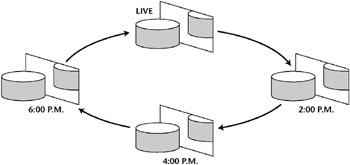Real-Time Backup
|
| < Day Day Up > |
|
Virtual Backup
The future is now, or at least portions of it, for we are seeing some of the virtual backup technologies today with the integration of current technologies. However, it hasn't made the main stage yet. This virtual backup feature involves making persistent frozen images of the data being protected and managing these images. The frozen image can be either a mirror or a snapshot. This offers a way for you to use disk storage to provide high-performance data protection, and it allows you to encompass several technologies capable of providing versioned frozen images of filesystems or volumes. These local versions can then be accessed during restoration, instead of the data being accessed on tape or remote storage, allowing you to protect your data 'instantaneously' via an automated and manual facility. In this way, the restoration of user data can be just as instantaneous as backups. The hope is to keep most differences in the underlying technologies away from you, the end user. If data was protected to tape or locally via a virtual backup, the user should be comfortable in locating and recovering either version of a file. This technology was actually introduced with VERITAS Software's NetBackup 4.5.
The implementation of this feature involves the integration of the frozen image technology with the backup technology. The real innovation is that the backup product controls the creation of the frozen images, catalogs the data in the frozen image, tracks the versions of the frozen images, and facilitates restores from the frozen image. You can configure the number of frozen images to be kept (versions) and how often they will be made. Since no data is actually transferred during the backup, this offers a very low impact backup option. The only real constraint is available disk space. The frozen images are disk images of the data, so the restore performance should also be almost instantaneous.
Figure 10.1 shows an example of doing virtual backups using VERITAS Software's VxVM mirrors. In this example, NetBackup is managing three mirrors plus the live volume. This gives the appearance of rotating mirrors. The concept is very similar with storage checkpoints. The biggest difference is that with the mirror model, you must allocate all the disk space for all the mirrors before initiating virtual backup. With storage checkpoints, the disk space is allocated as needed, and the disk space is deallocated as a checkpoint becomes obsolete. The mirrors potentially have less system overhead but will use more disk space.

Figure 10.1: Virtual backups.
Other software solutions perform similarly by making periodic, scheduled point-in-time copies of the data. These solutions contain the changes only and not the entire file; therefore, they do not take up a significant amount of storage. The solutions typically will integrate with most backup solutions via some type of pre- and post-processing scripts. The future of virtual backups will be led by the backup software vendors and most certainly validated by the emerging technology companies that will provide this in a cross-backup-platform solution.
|
| < Day Day Up > |
|
EAN: 2147483647
Pages: 176